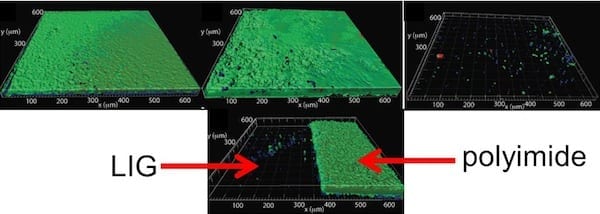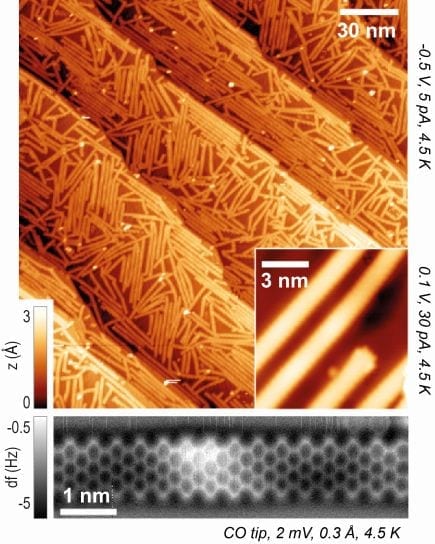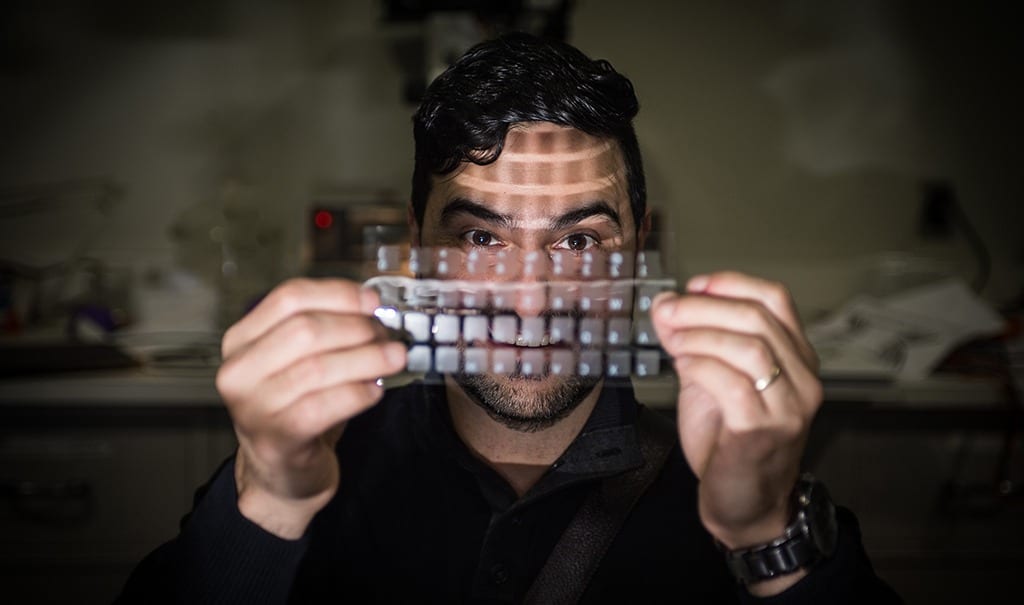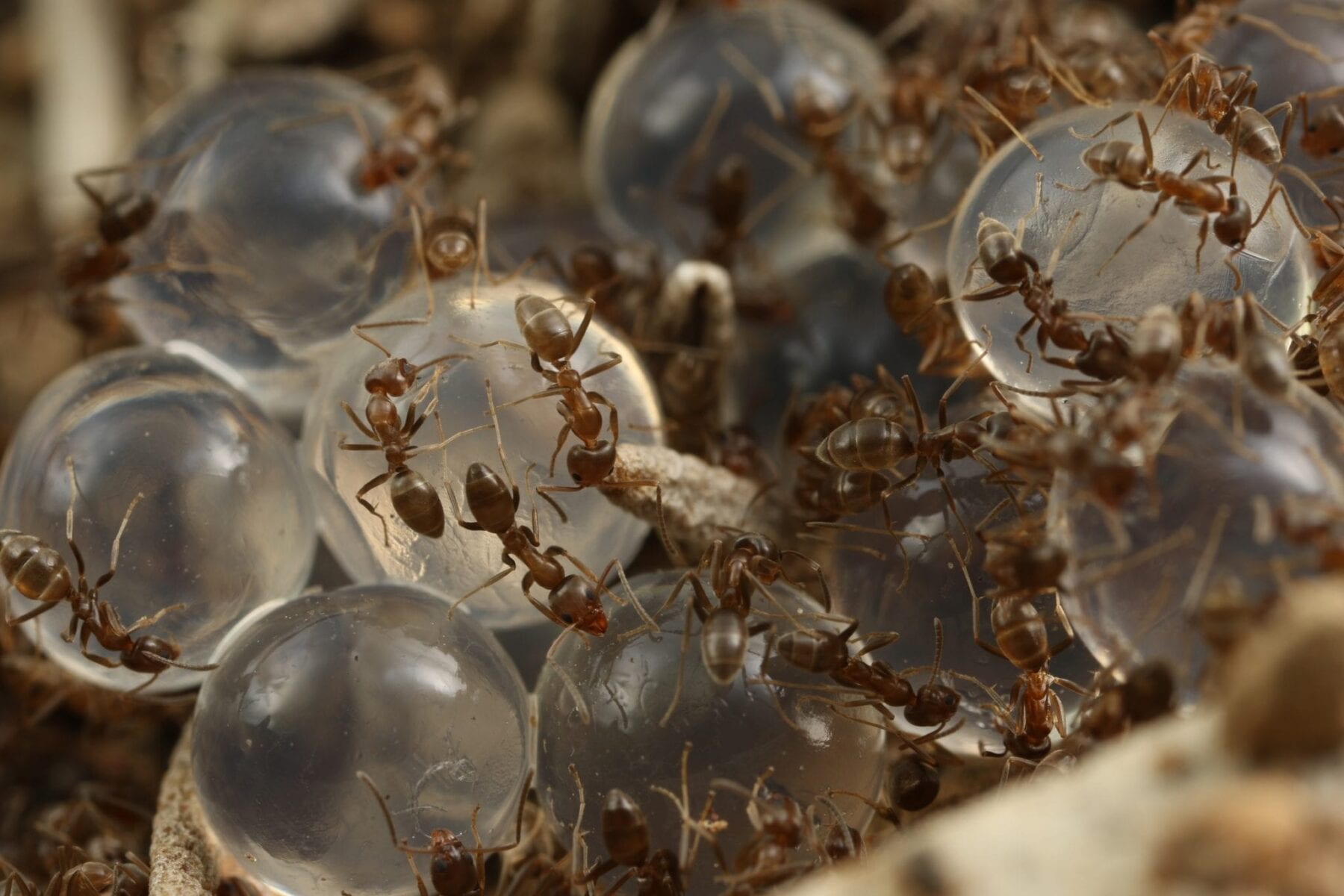
Rice, Ben-Gurion universities show laser-induced graphene kills bacteria, resists biofouling
Scientists at Rice University and Ben-Gurion University of the Negev (BGU) have discovered that laser-induced graphene (LIG) is a highly effective anti-fouling material and, when electrified, bacteria zapper.
LIG is a spongy version of graphene, the single-atom layer of carbon atoms. The Rice lab of chemist James Tour developed it three years ago by burning partway through an inexpensive polyimide sheet with a laser, which turned the surface into a lattice of interconnected graphene sheets. The researchers have since suggested uses for the material in wearable electronics and fuel cells and for superhydrophobic or superhydrophilic surfaces.
In this real-time video, Pseudomonas aeruginosa bacteria tagged with green fluorescent protein, which appear as bright dots, are drawn to an anode of laser-induced graphene, where they die. The anode at the top, which is separated from a cathode by a 100-micron channel, carries a small voltage that boosts its antibacterial properties. Courtesy of the Arnusch Lab/BGU
According to their report in the American Chemical Society’s ACS Applied Materials and Interfaces, LIG also protects surfaces from biofouling, the buildup of microorganisms, plants or other biological material on wet surfaces.
“This form of graphene is extremely resistant to biofilm formation, which has promise for places like water-treatment plants, oil-drilling operations, hospitals and ocean applications like underwater pipes that are sensitive to fouling,” Tour said. “The antibacterial qualities when electricity is applied is a great additional benefit.”
When used as electrodes with a small applied voltage, LIG becomes the bacterial equivalent of a backyard bug zapper. Tests without the charge confirmed what has long been known — that graphene-based nanoparticles have antibacterial properties. When 1.1 to 2.5 volts were applied, the highly conductive LIG electrodes “greatly enhanced” those properties.
Under the microscope, the researchers watched as fluorescently tagged Pseudomonas aeruginosa bacteria in a solution with LIG electrodes above 1.1 volts were drawn toward the anode. Above 1.5 volts, the cells began to disappear and vanished completely within 30 seconds. At 2.5 volts, bacteria disappeared almost completely from the surface after one second.
The Rice lab partnered with Professor Christopher Arnusch, a lecturer at the BGU Zuckerberg Institute for Water Research who specializes in water purification. Arnusch’s lab tested LIG electrodes in a bacteria-laden solution with 10 percent secondary treated wastewater and found that after nine hours at 2.5 volts, 99.9 percent of the bacteria were killed and the electrodes strongly resisted biofilm formation.
The researchers suspect bacteria may meet their demise through a combination of contact with the rough surface of LIG, the electrical charge and toxicity from localized production of hydrogen peroxide. The contact may be something like a knee hitting pavement, but in this case, the bacteria are all knee and the sharp graphene edges quickly destroy their membranes.
Fortunately, LIG’s anti-fouling properties keep dead bacteria from accumulating on the surface, Tour said.
“The combination of passive biofouling inhibition and active voltage-induced microbial removal will likely make this a highly sought-after material for inhibiting the growth of troublesome natural fouling that plagues many industries,” Tour said.
Read more: Zap! Graphene is bad news for bacteria
The Latest on: Laser-induced graphene
[google_news title=”” keyword=”laser-induced graphene” num_posts=”10″ blurb_length=”0″ show_thumb=”left”]- Local twist angles in graphene come into view
The new technique revealed pronounced variations in local twist angles in twisted bilayer graphene. (Courtesy: S Zhu) Stacking layers of two-dimensional materials on top of each other and varying the ...
- Laser-Induced Graphene Sensors for Wearable Gait Recognition
In a recent paper published in Microsystems & Nanoengineering, researchers integrated a pressure sensor array based on laser-induced graphene (LIG) and multiple sensor units into wearable gait ...
- Laser Induced Breakdown Spectroscopy
Analysis of Heavy Metal Pollution in Soil Using Transversely Excited Atmospheric CO2 Laser-Induced Plasma by Trapping the Soil in Microstructured Holes on Metal Subtargets. Applied Spectroscopy, Vol.
- Inkjet vs. Laser: Which printer is right for you?
Inkjet vs laser printers: Which one is right for you? This is the most basic and most essential question in printer shopping. You've no doubt wondered what differentiates the two technologies and ...
- Artificially Intelligent Manufacturing (AIM)
In addition, AIM PIs and associated researchers presented the latest results on applying state-of-the-art AI to laser-induced graphene production, atomistic modeling, and porous media modeling. The ...
via Google News and Bing News










